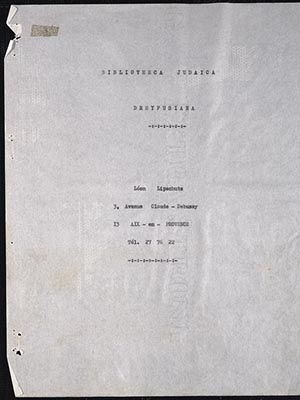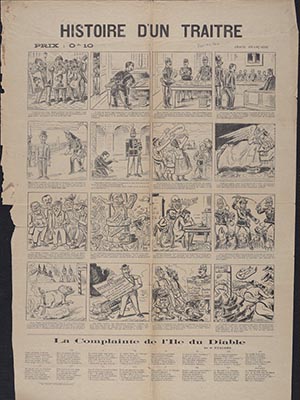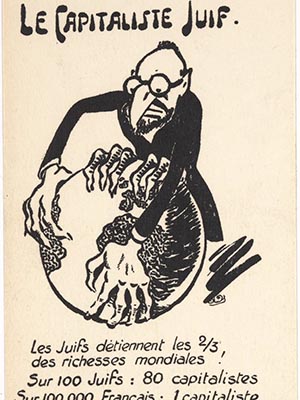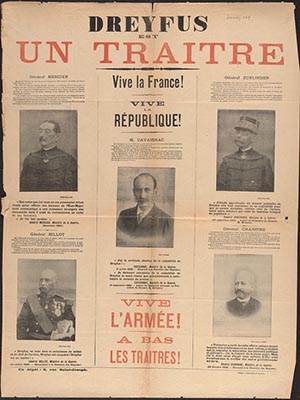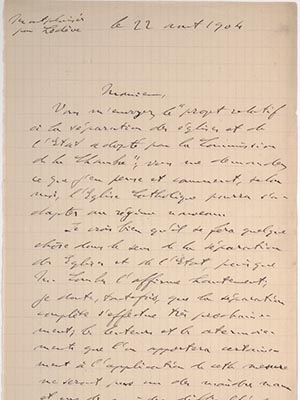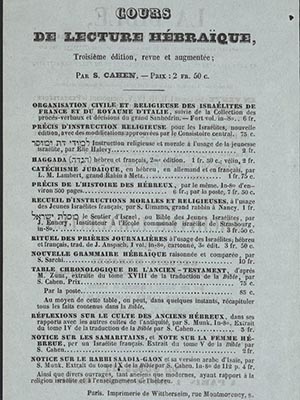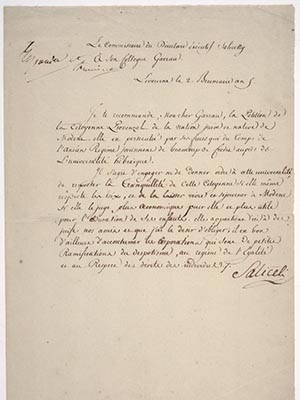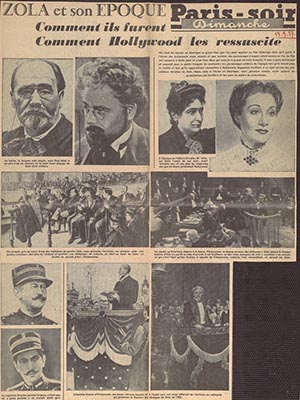Léon Lipschutz Collection of Dreyfusiana and French Judaica
June 24, 2009
Description by Surella Evanor Seelig, Archives and Special Collections Assistant and PhD candidate in the Comparative history program
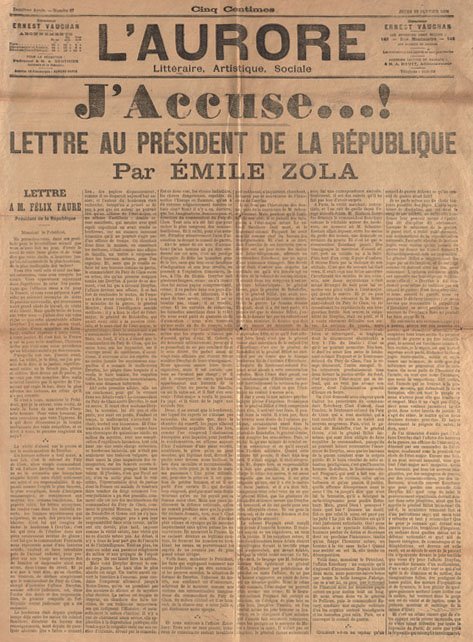 A fascinating and varied set of documents, the Léon Lipschutz collection of Dreyfusiana and French Judaica is a font of information for those interested in French history and Judaic studies. While the majority of the collection is made up of materials specifically related to the Dreyfus Affair—an explosive, all-encompassing and monumental episode in French and Jewish history—there is also a small but notable group of documents that focus more generally on Jewish life and intellectualism in France from the late 1700s to the mid-20th century.
A fascinating and varied set of documents, the Léon Lipschutz collection of Dreyfusiana and French Judaica is a font of information for those interested in French history and Judaic studies. While the majority of the collection is made up of materials specifically related to the Dreyfus Affair—an explosive, all-encompassing and monumental episode in French and Jewish history—there is also a small but notable group of documents that focus more generally on Jewish life and intellectualism in France from the late 1700s to the mid-20th century.
Several items in this collection, while generally classifiable under the headings of Dreyfusiana and French Judaica, will be of import as well to students of literature, biblical studies, numismatics and modern politics. One item in the collection dates from the French Revolutionary period: a letter written by revolutionary leader Christophe Saliceti to his colleague Garrau. In the letter—dated according to the Republican calendar—Saliceti champions the cause of a Jewish woman.
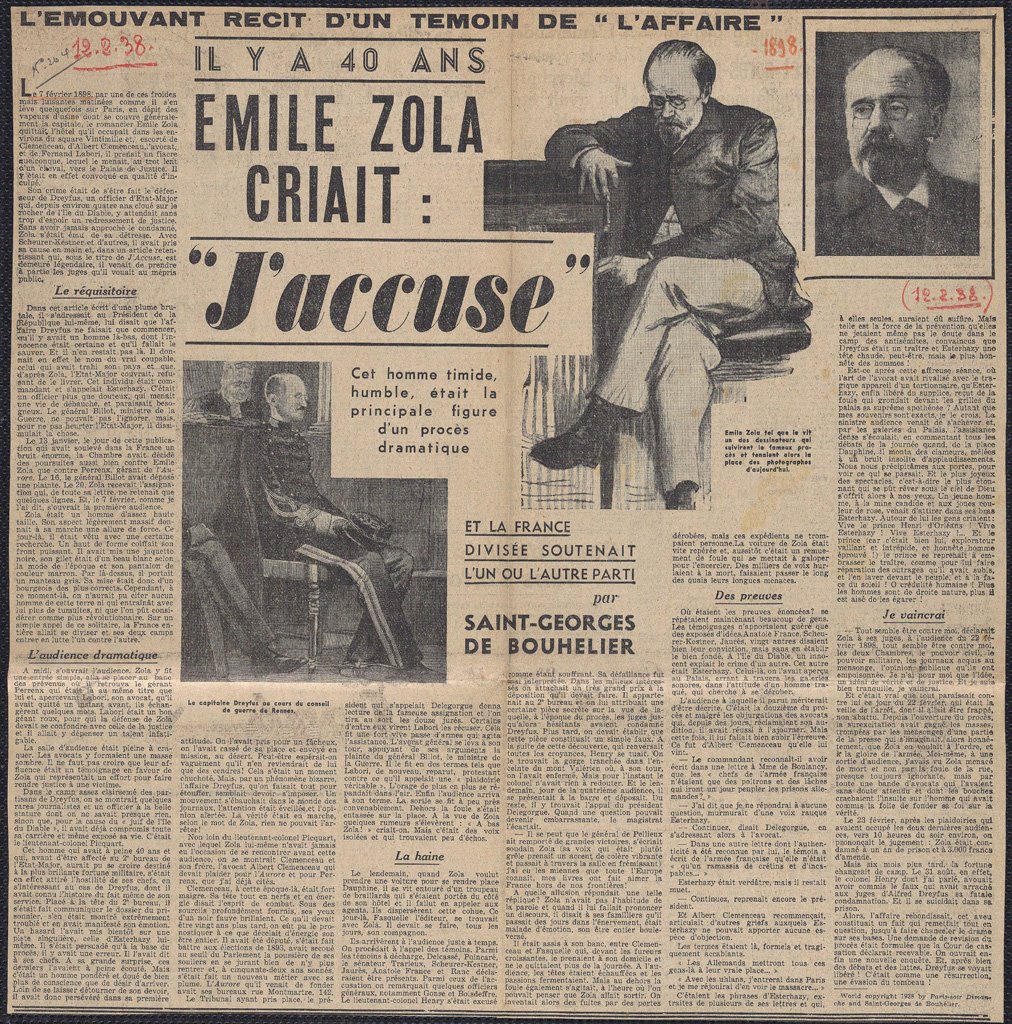 The guide to the collection, written by Léon Lipschutz, is key to understanding its contents. Mr. Lipschutz spent much of his life in Paris studying and collecting Dreyfusiana and Judaica and donating his acquisitions to various institutions. In his guide he does not merely list the items in the collection but organizes and analyzes them, providing cogent information and insight that will be useful to both the lay reader and the expert. This erudite documentation is more than a mere index; it is a source of critical scholarship.
The guide to the collection, written by Léon Lipschutz, is key to understanding its contents. Mr. Lipschutz spent much of his life in Paris studying and collecting Dreyfusiana and Judaica and donating his acquisitions to various institutions. In his guide he does not merely list the items in the collection but organizes and analyzes them, providing cogent information and insight that will be useful to both the lay reader and the expert. This erudite documentation is more than a mere index; it is a source of critical scholarship.
The Léon Lipschutz collection is composed primarily of Dreyfusiana. In general, the material can be divided into four series: books, letters/manuscripts, newspaper clippings and photographs. Ranging in date from the initial days of the Affair in 1894 to well into the 20th century, the material follows the way the Affair and its aftermath continued to play out in France and abroad, long after many of the major players had died.
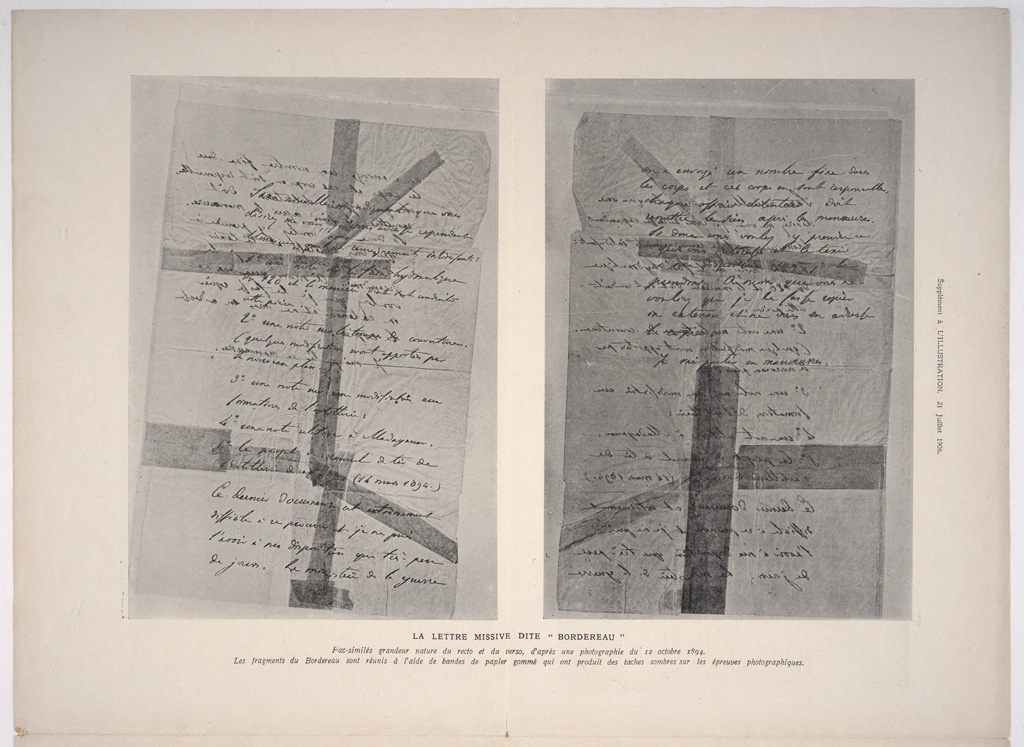 The Dreyfus Affair is a matter so complex and vital to recent French history, politics and culture that it has been the subject of innumerable plays, movies, newspaper reports, essays and scholarly texts. The event may be summarized as follows: In 1894 a young and successful Alsatian Jewish captain in the French military named Alfred Dreyfus was accused of sharing French military secrets with the Germans. This accusation was based on flimsy evidence backed up by a military establishment terrified of looking weak in the face of treason. The main piece of evidence was the “bordereau”—a ripped-up piece of paper offering information on French artillery developments, found by a French spy in the German embassy. By dint of poor handwriting analysis, this list was erroneously attributed to Dreyfus. Additional evidence was either trumped up or fabricated entirely. In short order Dreyfus was convicted and sentenced to Devil’s Island by a military tribunal.
The Dreyfus Affair is a matter so complex and vital to recent French history, politics and culture that it has been the subject of innumerable plays, movies, newspaper reports, essays and scholarly texts. The event may be summarized as follows: In 1894 a young and successful Alsatian Jewish captain in the French military named Alfred Dreyfus was accused of sharing French military secrets with the Germans. This accusation was based on flimsy evidence backed up by a military establishment terrified of looking weak in the face of treason. The main piece of evidence was the “bordereau”—a ripped-up piece of paper offering information on French artillery developments, found by a French spy in the German embassy. By dint of poor handwriting analysis, this list was erroneously attributed to Dreyfus. Additional evidence was either trumped up or fabricated entirely. In short order Dreyfus was convicted and sentenced to Devil’s Island by a military tribunal.
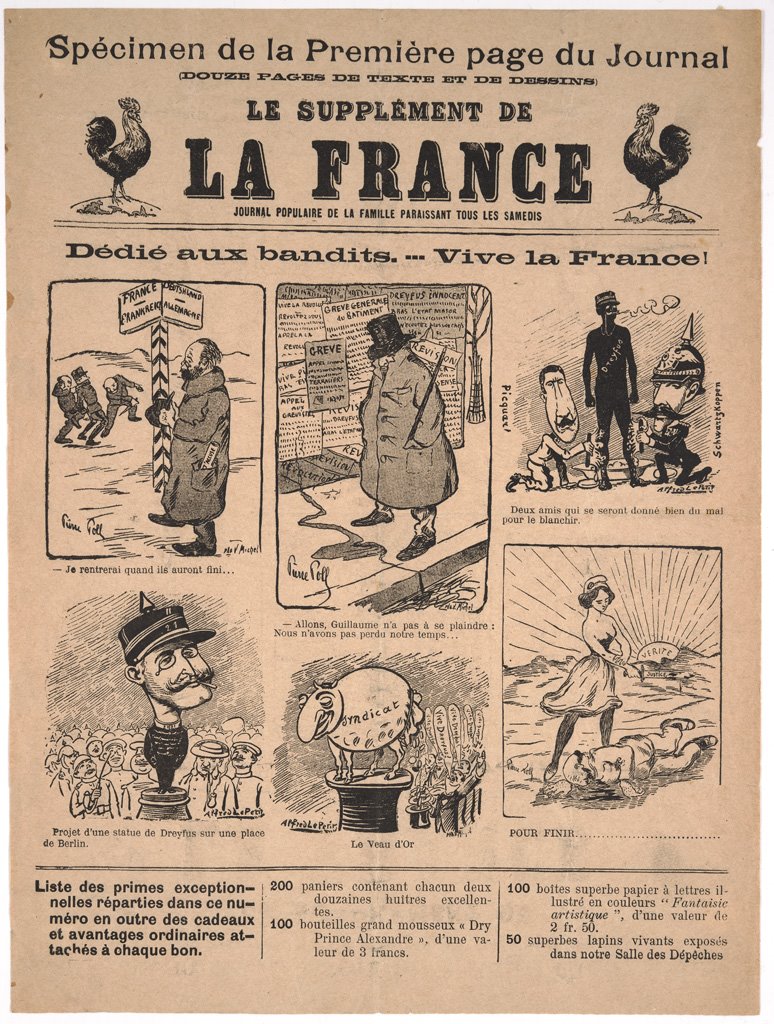 France, terrified from its recent defeat at the hands of the Germans in the Franco-Prussian War, imploded in fury over this ostensible act of treason and quickly divided into pro- and anti-Dreyfus camps. While many aspects of French culture at the turn of the 20th century laid the groundwork for the national debacle that was to become the Dreyfus Affair, a widespread anti-Semitism was a major factor. While Dreyfus’ professional success and his wealthy Alsatian background made him an easy scapegoat and target of hatred, it was the fact of his being a Jew that was the most damning piece of evidence of all. The Lipschutz collection includes several postcards and cartoons from the Dreyfus Affair that are blatantly anti-Semitic.
France, terrified from its recent defeat at the hands of the Germans in the Franco-Prussian War, imploded in fury over this ostensible act of treason and quickly divided into pro- and anti-Dreyfus camps. While many aspects of French culture at the turn of the 20th century laid the groundwork for the national debacle that was to become the Dreyfus Affair, a widespread anti-Semitism was a major factor. While Dreyfus’ professional success and his wealthy Alsatian background made him an easy scapegoat and target of hatred, it was the fact of his being a Jew that was the most damning piece of evidence of all. The Lipschutz collection includes several postcards and cartoons from the Dreyfus Affair that are blatantly anti-Semitic.
Émile Zola, the famous author and ardent supporter of Dreyfus, wrote “J’accuse!” a scathing open letter to the French president, which, with the help of Georges Clemenceau, was published on the front page of a major newspaper. The letter virulently attacked members of the government and military leadership, implicating them in a massive conspiracy against 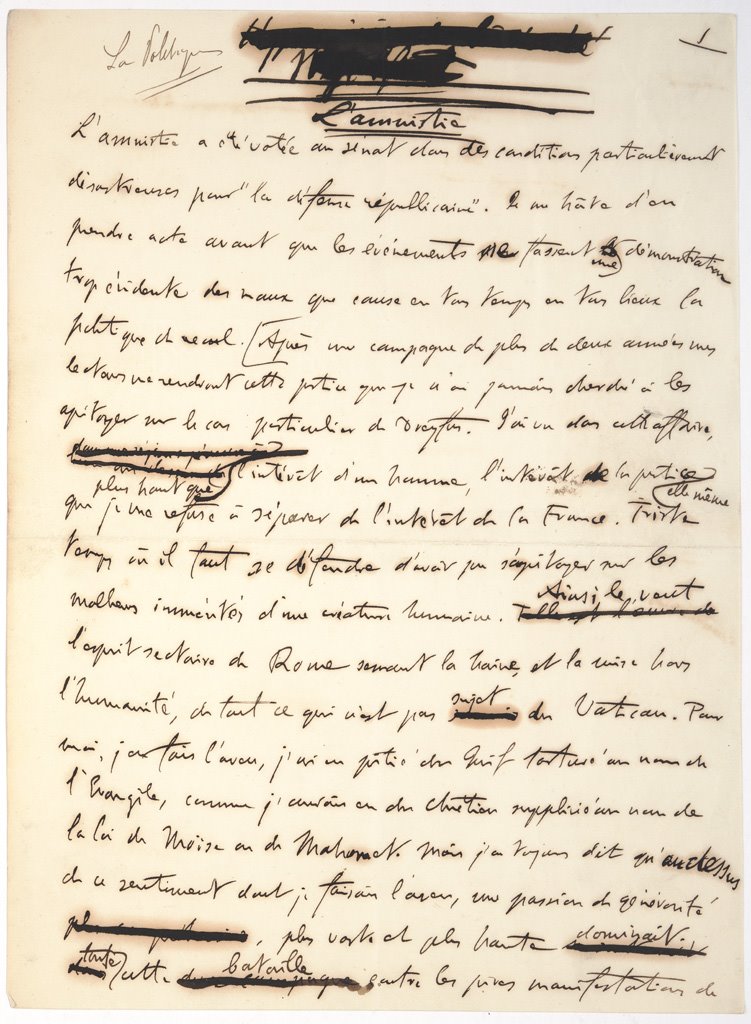 Dreyfus. Zola’s hope, which came to fruition, was that this letter would bring to light previously hushed-up details of Dreyfus’ case and force a retrial. One of the ways in which the French military attempted to protect itself was to declare a law of amnesty, making it virtually impossible to prosecute any of those who had been involved in the initial false conviction, forgery of documents and cover-up. Clemenceau wrote a forceful argument against this law of amnesty (the Lipschutz collection contains the handwritten manuscript draft of this piece by Clemenceau).
Dreyfus. Zola’s hope, which came to fruition, was that this letter would bring to light previously hushed-up details of Dreyfus’ case and force a retrial. One of the ways in which the French military attempted to protect itself was to declare a law of amnesty, making it virtually impossible to prosecute any of those who had been involved in the initial false conviction, forgery of documents and cover-up. Clemenceau wrote a forceful argument against this law of amnesty (the Lipschutz collection contains the handwritten manuscript draft of this piece by Clemenceau).
While Dreyfus was not exonerated until 12 years after the case, the appearance of “J’accuse!” stood as a pivotal moment in the Affair and in French and Jewish history. As Jacques Chirac, president of France, noted in a public address to the families of Dreyfus and Zola, given on the centennial of the appearance of “J’accuse!”:
“…a man stood up against lies, malice and cowardice. Outraged by the injustice against Captain Dreyfus, whose only crime was to be a Jew, Émile Zola cried out his famous “I Accuse…!” Published on January 13, 1898 by L’Aurore, this text struck minds like lightning and changed the fate of the Affair within a few hours. Truth was on the march.”[1]
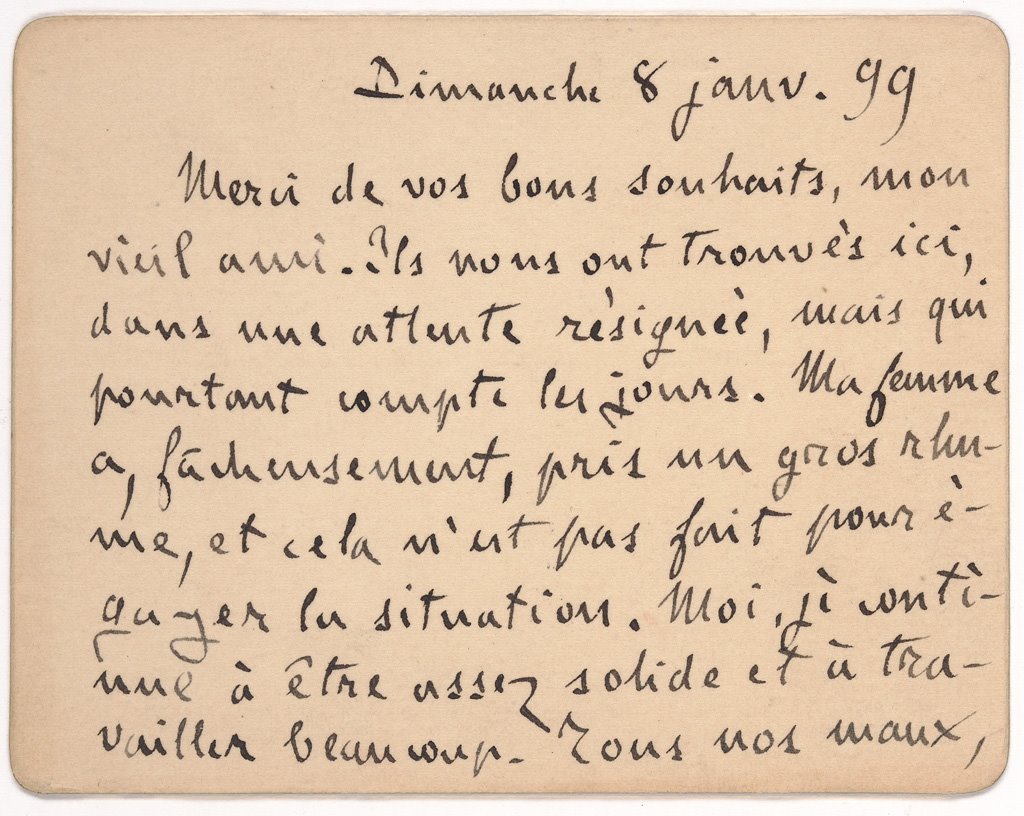 While his effort on behalf of Dreyfus was both noble and effective, Zola was not left unscathed by the resulting chaos and personal attacks. The Lipschutz collection contains several letters by Zola, one of which is especially affecting, about the pressures and distress he and his wife were suffering as a result of their involvement in the Affair:
While his effort on behalf of Dreyfus was both noble and effective, Zola was not left unscathed by the resulting chaos and personal attacks. The Lipschutz collection contains several letters by Zola, one of which is especially affecting, about the pressures and distress he and his wife were suffering as a result of their involvement in the Affair:
“Truly, the news which comes to me each morning in my solitude makes me despair. The crime passes all imagination. I have the darkest forebodings. I feel the ultimate attack is on its way. And what a dreadful debacle for our poor country! All that you write to me is correct—if there is no sudden awakening it will be the end of a nation. My wife is still very unwell… Do not give out my address here to people, because I desire more than ever to lock myself away, to disappear.”[2]
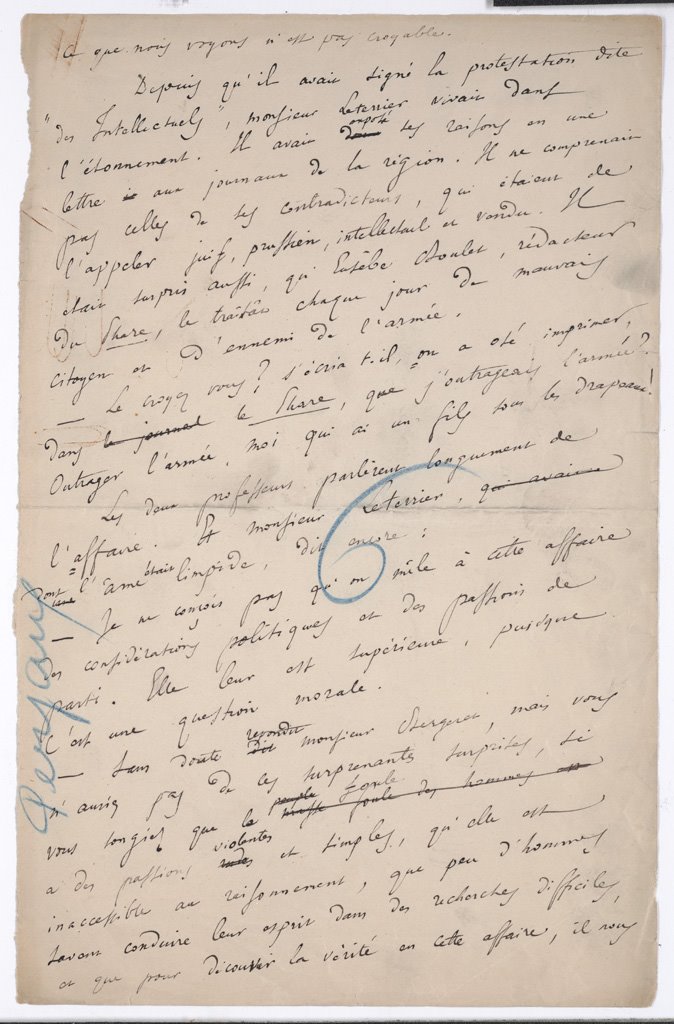 Zola was not the only member of the French intelligentsia to become involved in the Affair. In fact, with some notable exceptions, the majority of the intellectual elite in France was in the Dreyfusard camp. The Lipschutz collection contains a handwritten draft of L’Anneau d’améthyste by Anatole France, famed French author and winner of the 1921 Nobel Prize in Literature. While this novel does not touch upon the Affair, two other of his works do (Monsieur Bergeret and L’Île des Pingouins), and France himself was an ardent Dreyfusard who signed Émile Zola’s “J’accuse.” To the scholar interested in this manuscript, which allows virtual access to the author’s thought process, Mr. Lipschutz has given as well his own informed analysis of the draft and the way in which it relates both to the final published novel and to other discussions of France’s work.
Zola was not the only member of the French intelligentsia to become involved in the Affair. In fact, with some notable exceptions, the majority of the intellectual elite in France was in the Dreyfusard camp. The Lipschutz collection contains a handwritten draft of L’Anneau d’améthyste by Anatole France, famed French author and winner of the 1921 Nobel Prize in Literature. While this novel does not touch upon the Affair, two other of his works do (Monsieur Bergeret and L’Île des Pingouins), and France himself was an ardent Dreyfusard who signed Émile Zola’s “J’accuse.” To the scholar interested in this manuscript, which allows virtual access to the author’s thought process, Mr. Lipschutz has given as well his own informed analysis of the draft and the way in which it relates both to the final published novel and to other discussions of France’s work.
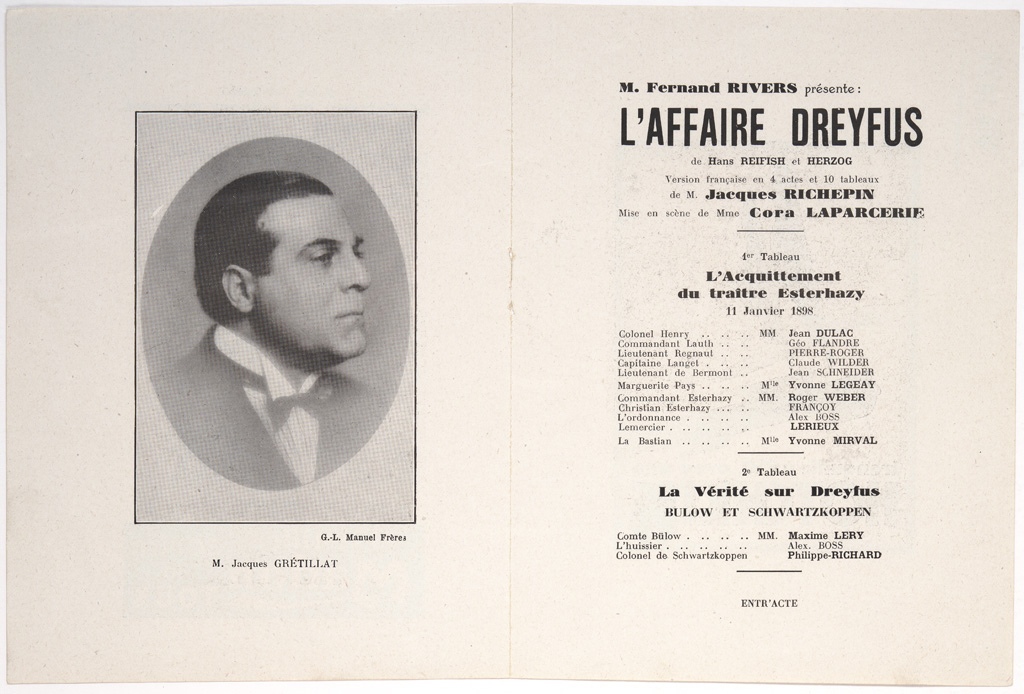 This is but one small portion of the Lipschutz collection, which will be useful to scholars in a myriad of disciplines. The entire collection has been digitized and will ultimately be available online, accompanied by transcriptions and translations. From essays on Jewish communities around France, to personal letters to and from the Dreyfus family attorney, to studio photographs of close to one hundred people associated with the Affair, the Lipschutz collection is a treasure trove of artifacts from recent French and Jewish history.
This is but one small portion of the Lipschutz collection, which will be useful to scholars in a myriad of disciplines. The entire collection has been digitized and will ultimately be available online, accompanied by transcriptions and translations. From essays on Jewish communities around France, to personal letters to and from the Dreyfus family attorney, to studio photographs of close to one hundred people associated with the Affair, the Lipschutz collection is a treasure trove of artifacts from recent French and Jewish history.
Notes
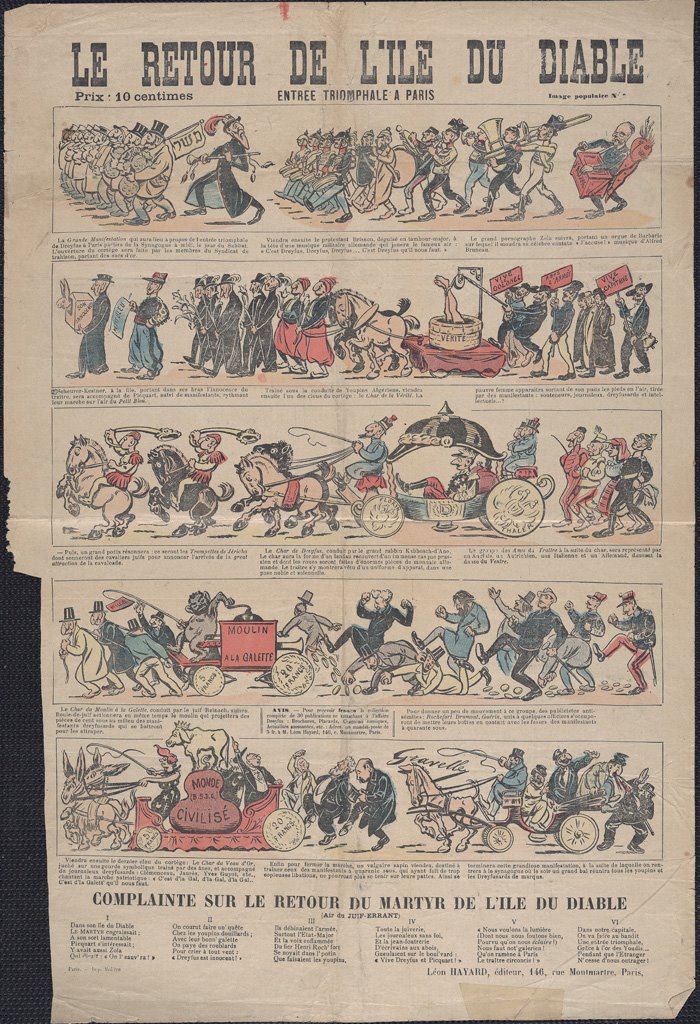 translation by Jean-Max Guieu, Georgetown University; see Dr. Guieu's "Chronology of the Dreyfus Affair" webpage.
translation by Jean-Max Guieu, Georgetown University; see Dr. Guieu's "Chronology of the Dreyfus Affair" webpage.- translation by Surella Seelig and Julian Nemeth, Brandeis University
